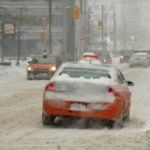Top Winter Storms in New York History

New York has had a long history of major winter storms, a fact that does not look like it is going to change anytime in the near future. In the early part of November 2014, Buffalo and the western portion of New York State were bombarded by snowstorms that left up to five and a half feet of snow on the ground. That was not the end: Up to 88 inches (7.33 feet) of snow reportedly fell between Nov. 17-21 in the Buffalo Southtowns.
It is expected that New York and the rest of the East Coast states are in for a very heavy winter in 2014-15.
Here are some of the top winter storms in New York history (based on snowfall accumulation):
The Blizzard of December 2010
In December 2010, New York City was blanketed by 20 inches of snow after a strong nor’easter tore through. Snow was reportedly falling at a rate of one to three inches per hour in certain areas. New York saw quite a bit of snow during the course of the 2010-2011 winter season, with more than 56 inches of snowfall in the month of January alone.
The Storm of February 2006
On Feb. 12, 2006, a low-pressure system moved in across New York, Long Island and southern New England. In some areas, snow was falling at a rate of three to four inches per hour. The total snowfall recorded at the Central Park Zoo’s weather station was 26.9 inches, the entirety of which had fallen over a 16-hour period. LaGuardia Airport reported 25.4 inches of snow on the ground. Many flights in and out of New York were cancelled, and railroad service had to be temporarily shut down. Subway delays were extensive and the city’s bus service was only able to run at 50 percent capacity.
President’s Day Storm in February 2003
This particular storm was the third that eastern portions of New York had that season. Close to 24 inches of snow fell on President’s Day that year, costing the city around $20 million. Transportation hubs in and out of the city either experienced major delays or had to be completely shut down.
Blizzard of January 1996
During the blizzard of January 1996, more than 20 inches of snow fell over the two-day period between Jan. 7-8. Travel was very limited and the state experienced widespread power outages. By Jan. 8, New York City public and parochial schools had to be closed. Many Broadway shows also cancelled performances and the New York Stock Exchange cut its day short. By the end of the 1995-1996 winter season, 16 snowstorms had hit New York City dropping an estimated 89 inches of snow.
March 1993’s “Storm of the Century”
On March 13, the “storm of the century” barreled its way across much of the eastern United States. This storm dropped a record 10.2 inches of snow in Central Park alone and Syracuse, N.Y. got more than 40 inches of snow. In mountainous areas, such as the Catskills, snow totals reached 50 inches or more. This storm was the first time in history NOAA’s Weather Service was able to accurately predict a storm of this size and provide warning to people and places in its path.
The New England Blizzard of February 1978
While this storm was primarily focused on the coastal portions of New England, mid-Manhattan received a total of 17.7 inches of snow from this blizzard between Feb. 6-7. The Catskills also received quite a heavy downfall, with more than 25 inches being reported in Prattsville, N.Y.
Buffalo Blizzard of 1977
This storm is widely recognized as the one that gave Buffalo its reputation as the “blizzard capital of the United States.” Visibility during this storm was very low, with wind gusts as high as 74 mph at times. As a result of the sudden drop in temperature this blizzard caused, many residents and travelers were left stranded with little notice. A reported 199.4 inches of snow in total fell during that winter season.
The Thanksgiving Storm of 1971
This heavy storm came into New York the day before Thanksgiving and continued into Thanksgiving Day. Albany was left with 22.5 inches of snow and other areas throughout New York reported as much as 30 inches of snow on the ground. Due to it’s timing, this particular storm was a nightmare for holiday travelers.
Christmas Snowstorm of 1969
By the time this storm came in, there was already around a foot of snow on the ground. Albany recorded a total of 26.7 inches of snow, making it the third most significant storm on record to date. Reportedly, it took the City of Albany’s Public Works more than a month of round-the-clock snow removal before things began returning to normal.
Blizzard of February 1958
While this blizzard affected a wide section of the northeast, it brought close to 18 inches of snow to Albany. This resulted in travel to many areas to next to impossible. At one point, the situation became so dire that “Operation Haylift” was set in motion so helicopters could make food drops for cattle stranded by the storm.
The Blizzard of December 1947
As this storm rolled through, 26.4 inches of snow was dropped in Central Park between Dec. 26-27. Snow paralyzed many parts of the city. Many forms of public transportation were brought to a standstill and many residents and travelers were left stranded. This storm was reported to have held the previous record for “the biggest snowstorm in New York City history.”
The Surprise Blizzard of March 1888
This storm hit the city by surprise as it came in quickly at the tail end of a warm March day. In actuality, this blizzard was comprised of two storms, one from the south and one from the north. As the storms met, 21 inches of snow fell in New York City over a two- to three-day period. Wind from the storm created snowdrifts as high as 30 feet. Total snowfall was reportedly more than 46 inches. However, outlying areas, such as Saratoga Springs, N.Y., received upwards of 58 inches and Albany was essentially shut down for days, as country roads were impassable. While this storm was the third largest in recorded history, some areas of New York still categorize this as “the worst winter storm on record.”
“Just in Case” — Preparing for Winter Weather Driving
If you plan on traveling to New York City, or other areas throughout the state during winter months, it is important you are properly prepared for winter weather driving. The following are a few tips that will help you winterize your car and keep you safe when the next storm strikes:
- Get a complete vehicle inspection done (check your vehicle’s battery life, top off antifreeze and other fluid levels, check the ignition system, check lights, thermostat, exhaust system, heater, brakes, tire pressures, defroster, oil levels, etc.).
- Keep your vehicle’s gas tank at least half way full at all times to help prevent freezing.
- Put on winter tires, or make sure the existing tires have adequate tread.
- Keep a first-aid first and emergency kit (with tools, jumper cables, flares, etc.) in your vehicle.
- During winter months, you will also want to keep extra blankets, jackets, hats, scarves, additional change of clothes and other such supplies in your vehicle.
- Make sure you have chains for your vehicle and a spare tire (with working jack and lug wrench).
- Make sure you take a cell phone and cell phone car charger with you.
Before you get on the road, check local weather stations to find out what the forecast will be along your route. Map out your route, including potential places to stop and seek shelter if necessary. Plan to do as much travel as possible either before or after the storm so you do not need to be on the roads in bad weather.
If you do get stranded, remain in your vehicle until help arrives. Keep at least one window partially open so you and your passengers do not end up with carbon monoxide poisoning caused by your vehicle’s tail pile getting blocked by snow or debris.
The most important aspect of winter weather traveling is being prepared. Make sure you and your family is adequately prepared for whatever upcoming storms may bring.
Sources:
- CNN: Buffalo area braces for more snow
- com: November 2014 Shattered Cold and Snow Records For Some
- National Weather Service: Major Winter Storms
- New York City Office of Emergency Management: NYC Hazards: Winter Storm History
- How Stuff Works: 10 Biggest Snowstorms of all Time












